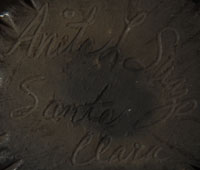Santa Clara Pueblo Black Melon-ribbed Jar [SOLD]
+ Add to my watchlist Forward to Friend
- Category: Modern
- Origin: Santa Clara Pueblo, Kha'p'oo Owinge
- Medium: clay
- Size: 4” height x 5-1/4” diameter
- Item # C3752B SOLD
Melons were among the earliest plants to be domesticated in both the Old and New Worlds. Early European settlers in the New World are recorded as growing honeydew and casaba melons as early as the 1600s. A number of Native American tribes in New Mexico, including Acoma, Cochiti, Isleta, Navajo, Santo Domingo and San Felipe, maintain a tradition of growing their own characteristic melon cultivars, derived from melons originally introduced by the Spanish.
 It is from the shape of melons that the pottery melon jar evolved. It resembles cantaloupe with its globular shape and vertical ribs. The melon jar seems to have developed at Santa Clara Pueblo with the most renown potters Helen Shupla and Angela Baca being the ones who specialized in making them. Other potters followed the tradition
It is from the shape of melons that the pottery melon jar evolved. It resembles cantaloupe with its globular shape and vertical ribs. The melon jar seems to have developed at Santa Clara Pueblo with the most renown potters Helen Shupla and Angela Baca being the ones who specialized in making them. Other potters followed the tradition
This melon jar by Anita Suazo differs from those of Shupla and Baca in that the rib surface is flat and the cuts between them are deep and left in a matte finish. Shupla pushed the ribs outward from the inside and they were rounded and the sections between ribs were polished. Baca shaped her ribs from the exterior and also polished the depressions between protruded ribs.
This jar is an excellent example of the style by Anita Suazo, who was a daughter of Belen Tapia, another famous Santa Clara potter. Anita’s mom was her mentor.
Condition: original condition
Recommended Reading: Santa Clara Pottery Today by Betty LeFree
Provenance: from the collection of a family from Oregon who purchased it in 1986 from Adobe Gallery
- Category: Modern
- Origin: Santa Clara Pueblo, Kha'p'oo Owinge
- Medium: clay
- Size: 4” height x 5-1/4” diameter
- Item # C3752B SOLD



